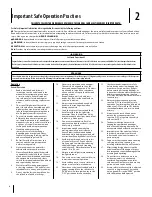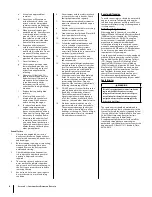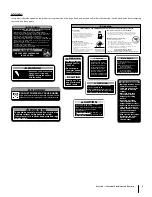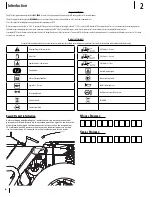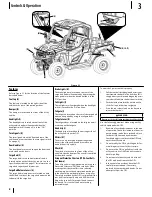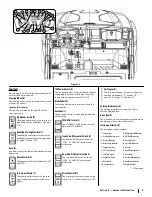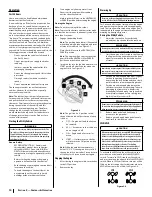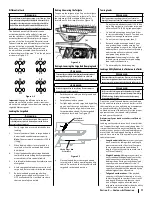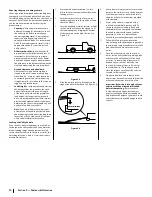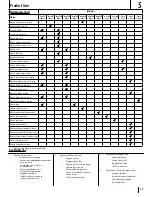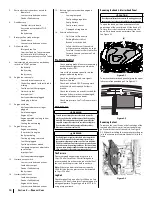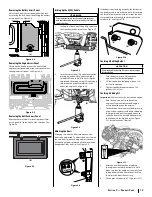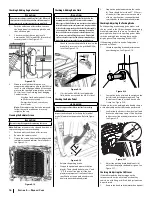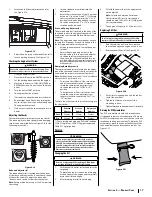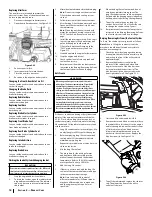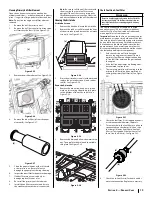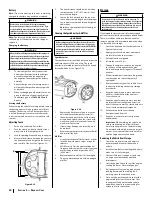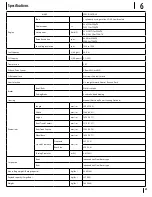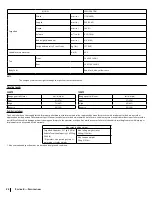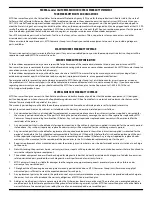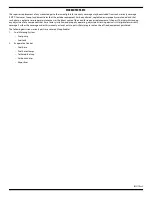
12
S
ection
3 — c
ontrolS
& o
peration
Choosing the proper loading ramp(s)
Choosing a reliable ramp and understanding how
to properly use it is far and above the best option
for safely loading a utility vehicle into your truck or
onto your trailer. Take a look at the considerations
you should have in mind when choosing the
proper ramp(s):
•
Capacity:
Utility vehicles are not evenly
balanced, meaning it’s necessary to check
the axle weights before you make any
choices regarding ramps. A typical ramp’s
capacity is based upon two axles with
equally distributed loads. We recommend
3,000-lb minimum capacity ramp(s) as the
appropriate option for your two-person
utility vehicle.
•
Offset track widths:
Your utility vehicle
has an offset track width front and rear, it’s
important to factor this in to your ramp
placement and ramp width needs. Ramps
need to be wide enough to accommodate
the difference in the distances between the
front two wheels and the rear two wheels.
•
Ground clearance and wheelbase:
Utility vehicles which have low ground
clearance (under 4”) and a relatively long
wheelbase (98” or more), make them prone
to bottoming out at the crest when using
straight ramps. As a solution to this issue we
suggest using arched ramps.
•
Load Height:
As with any ramp application,
the distance from the ground to the truck
bed or trailer impacts the overall length
of the ramp you will need, the greater the
load height, the longer the ramp should
be. Some ramp manufacturers and retailers
provide load height calculators to help you
determine the correct ramp length you will
need to safely load your vehicle.
Note:
If you are still unsure of what types
of ramps you will need to get the job done
and are having trouble understanding these
instructions, check with your local ramp or
utility vehicle retailer for assistance.
Loading the Utility Vehicle
If your truck or trailer’s load capacity is sufficient
to transport the utility vehicle and you obtain the
proper loading ramps and equipment to safely
secure the utility vehicle to the truck or trailer, the
only thing left to do is load it. Here’s how to best
accomplish this task:
1.
Proceed with extreme caution. It is very
difficult to overcome a mistake while in the
loading process.
2.
Park the truck or trailer in a flat area, set
the parking brake, turn the ignition off and
chock the wheels.
3.
Face the truck bed or trailer towards a slight
incline, which will reduce the steepness of
the loading angle by bringing the bottom
of the ramps up on the slight incline. See
Figure 3-8.
Figure 3-8
4.
Place the ramp fingers or plate edges on the
edge of the trailer or truck bed. See Figure 3-9.
Figure 3-9
5.
Use tie-down straps or cables to secure the
ramps to the trailer or truck, via the bumper
(steel bumpers only) or trailer hitch safety
chain loops. Refer to instructions provided
with the ramp.
6.
If your utility vehicle is supplied with a
roof and/or windshield, remove or fully
secure them prior to loading. Roofs and
windshields are not designed to withstand
the wind speeds that the open road can
generate, so it’s best to remove them
entirely to prevent any damage or accidents.
7.
Follow all safety rules provided in this
manual along with the manuals supplied by
the trailer and ramp manufacturer. Carefully
load the utility vehicle onto the truck or
trailer.
8.
Once the utility vehicle is on the truck or
trailer, set the utility vehicle’s parking brake
and secure the utility vehicle to the truck
or trailer. Tie-down strap placement will
depend on your truck or trailer. Be sure
to use only tie down straps sufficient for
the load capacity. If loaded onto a truck,
close the tailgate once the utility vehicle is
secured to the truck bed.
9.
Stop periodically to ensure that your tie-
down straps have not loosened and that the
utility vehicle remains securely in place.
Important:
Know the total height of your
vehicle with the utility vehicle loaded
before transporting.
Be sure to check
for low clearance bridges, doorways etc.
prior to traveling under them, the added
height above the height of your truck could
cause clearance issues and damage to both
vehicles
Содержание 550 2017
Страница 23: ...Notes 7 23...
Страница 24: ...24 Section 7 Notes...
Страница 25: ...25 Section 7 Notes...


